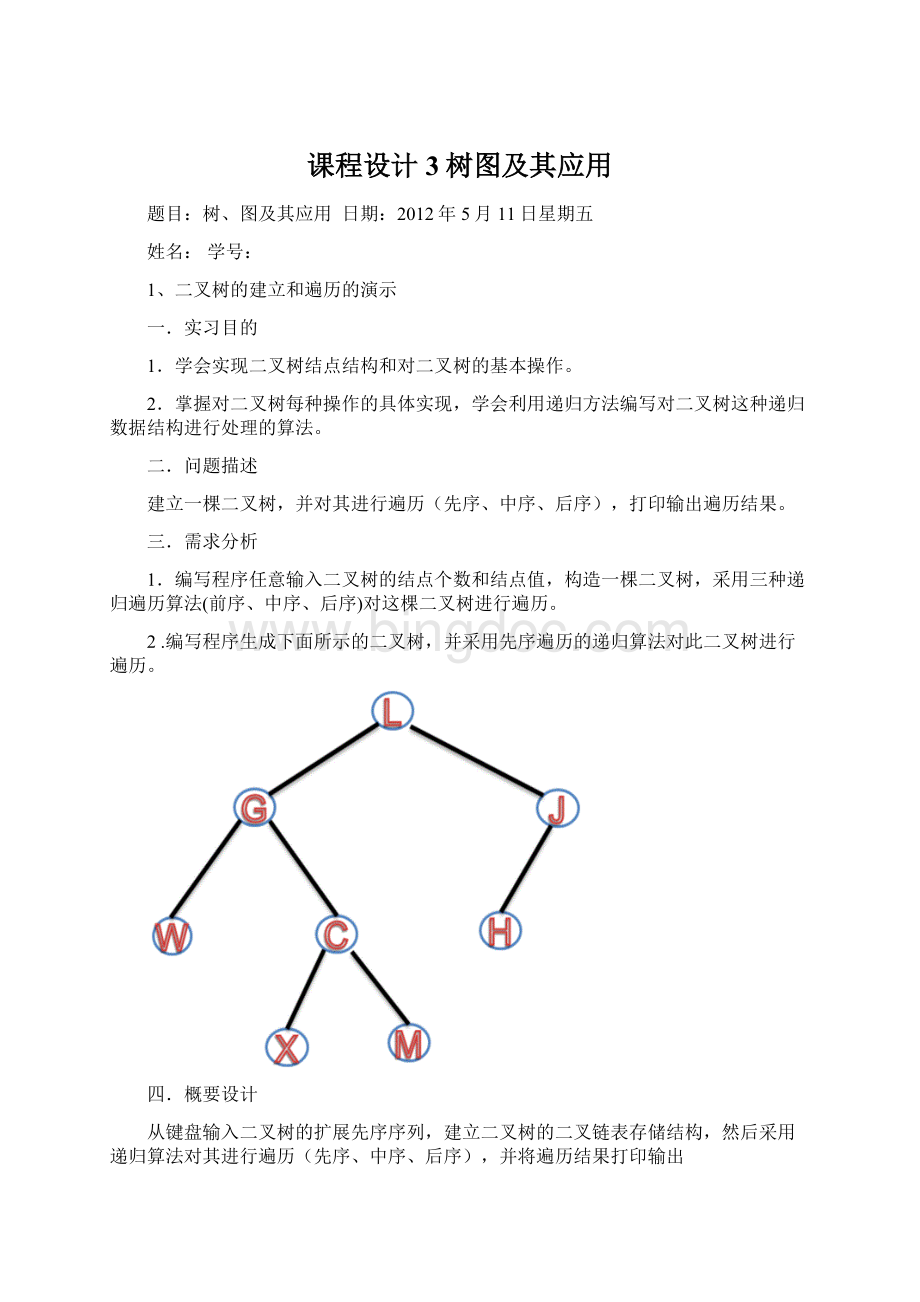课程设计3树图及其应用.docx
《课程设计3树图及其应用.docx》由会员分享,可在线阅读,更多相关《课程设计3树图及其应用.docx(23页珍藏版)》请在冰点文库上搜索。

课程设计3树图及其应用
题目:
树、图及其应用日期:
2012年5月11日星期五
姓名:
学号:
1、二叉树的建立和遍历的演示
一.实习目的
1.学会实现二叉树结点结构和对二叉树的基本操作。
2.掌握对二叉树每种操作的具体实现,学会利用递归方法编写对二叉树这种递归数据结构进行处理的算法。
二.问题描述
建立一棵二叉树,并对其进行遍历(先序、中序、后序),打印输出遍历结果。
三.需求分析
1.编写程序任意输入二叉树的结点个数和结点值,构造一棵二叉树,采用三种递归遍历算法(前序、中序、后序)对这棵二叉树进行遍历。
2.编写程序生成下面所示的二叉树,并采用先序遍历的递归算法对此二叉树进行遍历。
四.概要设计
从键盘输入二叉树的扩展先序序列,建立二叉树的二叉链表存储结构,然后采用递归算法对其进行遍历(先序、中序、后序),并将遍历结果打印输出
五.详细设计(给出算法的伪码描述)
六.测试分析
白盒测试:
查看代码完整性
黑盒测试:
结构是否完整
七.使用说明
八.附录:
测试数据
测试内容
测试结果
输入扩展先序序列:
L(G(W,C(X,M)).J(H))
正确
先序遍历为:
LGWCXMJH
正确
中序遍历为:
WGXCMLHJ
正确
后序遍历为:
WXMCGHJL
正确
九.附C语言实现源码
#include
#include
#include
#defineMaxNode100
typedefintElemType;
typedefstructnode
{
ElemTypedata;
structnode*lchild;
structnode*rchild;
}BTNode;
voidCreateTree(BTNode*&b,char*str)//建立二叉树
{
BTNode*St[100];
BTNode*p=NULL;
inttop=-1,k,j=0;
charch;
b=NULL;
ch=str[j];
while(ch!
='\0')
{
switch(ch)
{
case'(':
top++;St[top]=p;k=1;break;
case')':
top--;break;
case',':
k=2;break;
default:
p=(BTNode*)malloc(sizeof(BTNode));
p->data=ch;
p->lchild=p->rchild=NULL;
if(b==NULL)
b=p;
else
{
switch(k)
{
case1:
St[top]->lchild=p;break;
case2:
St[top]->rchild=p;break;
}
}
}
j++;
ch=str[j];
}
}
voidPreOrder(BTNode*b)//前序遍历
{
if(b!
=NULL)
{
printf("%c",b->data);
PreOrder(b->lchild);
PreOrder(b->rchild);
}
}
voidInOrder(BTNode*b)//中序遍历
{
BTNode*p,*stack[MaxNode];
inttop=0;
if(b==NULL)return;
p=b;
while(!
(p==NULL&&top==0))
{
while(p!
=NULL)
{
if(topelse{printf("栈溢出");return;}
p=p->lchild;
}
if(top<=0)return;
else{
top--;
p=stack[top];
printf("%c",p->data);
p=p->rchild;}
}
}
voidLaOrder(BTNode*b)//后序遍历
{
if(b!
=NULL)
{
LaOrder(b->lchild);
LaOrder(b->rchild);
printf("%c",b->data);
}
}
voidmain()
{
intnumber;
BTNode*b=NULL;
cout<<"1创建树"<cout<<"2先序遍历树"<cout<<"3中序遍历树"<cout<<"4后序遍历树"<cout<<"5退出"<cout<<"请您的选择"<cin>>number;
while(number!
=5)
{
if(number==1)
{
charstr[100];
printf("请输入:
");
scanf("%s",&str);
CreateTree(b,str);
printf("树创建成功!
\n");
}
elseif(number==2)
{
if(b==NULL)
{
printf("对不起,您还没有创建树!
\n");
}
else
{
printf("先序遍历树为:
");
PreOrder(b);
printf("\n");
printf("\n");
}
}
elseif(number==3)
{
if(b==NULL)
{
printf("对不起,您还没有创建树!
\n");
}
else
{
printf("中序遍历树为:
");
InOrder(b);
printf("\n");
printf("\n");
}
}
elseif(number==4)
{
if(b==NULL)
{
printf("对不起,您还没有创建树!
\n");
}
else
{
printf("后序遍历树为:
");
LaOrder(b);
printf("\n");
printf("\n");
}
}
printf("请您选择:
\n");//1:
创建树;2:
先序遍历;3:
中序遍历;4:
后序遍历;5:
退出
scanf("%d",&number);
}
}
十.附程序运行结果截图
创建树:
先序遍历结果:
中序遍历结果:
后序遍历结果:
2、图遍历的演示
一.实习目的
学会以图的遍历操作为基础的,试写一个程序,演示无向图的遍历操作
二.问题描述
很多涉及图上操作的算法都是以图的遍历操作为基础的。
试写一个程序,演示无向图的遍历操作,要求以邻接表为存储结构,实现连通无向图的深度优先和广度优先遍历。
以用户指定的结点为起点,分别输出每种遍历下的结点访问序列和相应生成树的边集。
三.需求分析
1.以邻接表为存储结构,实现连通无向图的深度优先和广度优先遍历。
以用户指定的结点为起点,分别输出每种遍历下的结点访问序列和相应生成树的边集。
2.每个结点用一个编号表示(如果一个图有n个结点,则它们的编号分别为1,2,…,n)。
通过输入图的全部边输入一个图,每个边为一个数对,可以对边的输入顺序作出某种限制。
注意,生成树的边是有向边,端点顺序不能颠倒。
3.
(1)建立无向图G的邻接表表示。
按照用户输入顶点数,弧数.各边(弧尾,弧头)
(2)输出图中边的表示。
用(A,B)表示
(3)实现无向图的深度优先搜索遍历。
实现无向图的广度优先搜索遍历,使用辅助队列q以存储已经被访问的路径长度为1,2,```的顶点,并且访问标志数组visited,实现对图的遍历。
四.概要设计
六.详细设计(给出算法的伪码描述)
六.测试分析
测试数据:
输入图的顶点数和弧数:
格式:
顶点数,弧数;
输入图的顶点数:
6;
输入图的弧数:
9;
接着输入各顶点:
1*2*3*4*5*6(*代表“回车键”);
接着输入各条弧(边):
1*2*1*3*1*6*2*3*3*4*3*5*3*6*4*5*5*6(*代表“回车键”);
七.使用说明
顶点数和弧数固定好后,必须按所对应的边输入顶点到顶点的边名。
八.附录:
测试数据
输入图的顶点数:
6个,弧数:
9条,各顶点为1、2、3、4、5、6,各边为:
12,13,16,23,34,35,36,45,56如图:
九.附C语言实现源码
#defineMAX_VERTEX_NUM2000
#include
#include
typedefstructarcnode//弧
{
intadjvex;
structarcnode*nextarc;
intinfo;
}arcnode;
typedefstructvnode//结点
{
chardata;
arcnode*firstarc;
intmark;
}vnode,adjlist[MAX_VERTEX_NUM];
typedefstruct//图
{
adjlistvertices;
intvexnum,arcnum;
}algraph;
typedefstructcsnode//树
{
vnode*data;
structcsnode*firstchild,*nextsibling;
}csnode;
typedefstructqueue//队列
{
vnode*data;
structqueue*next;
}queue;//队列
main()
{
voidbulidalgraph(algraph*g);//创建图
voiddfstree(algraph*g,inti,csnode*t);//深度优先遍历生成树
voidbfstree(algraph*g,inti,csnode*t);//广度优先遍历生成树
voidpreordertraverse(csnode*t);//树的遍历
intpreordertraverse1(inti,chara[40][23],csnode*t,intj);//将二叉树的图对应输入到数组中
voidpreordertraverse3(csnode*t);//输出树的边集
algraphg;
arcnode*p;
csnode*tree1,*tree2;
inti,j,m,n,flag1=1,flag2=1;
charb[40][23],ch;//留作输出树的图
tree1=tree2=NULL;
bulidalgraph(&g);
system("cls");
for(i=0;i{
for(p=g.vertices[i].firstarc;p;p=p->nextarc)
printf("%c,%c",g.vertices[i].data,g.vertices[p->adjvex].data);
printf("\n");
}
printf("\n请输入要进行遍历的模式:
\n\n1.深度优先遍历并生成树\n2.广度优先遍历并生成树\n\n");
fflush(stdin);
scanf("%d",&j);
if(j==1)//深度优先遍历
{
for(i=0;iif(!
g.vertices[i].mark)//如果没有遍历过
{
if(!
(tree1=(csnode*)malloc(sizeof(csnode))))exit
(1);
tree1->data=g.vertices+i;
tree1->firstchild=tree1->nextsibling=NULL;
if(!
tree2)tree2=tree1;
else
tree2->nextsibling=tree1;
tree2=tree1;
dfstree(&g,i,tree1);
}
printf("恭喜你深度优先遍历操作完成,请进行下一步操作\n1.输出树\n2.输出树图\n3.输出树的边集\n其他输入为退出本程序\n");
}
elseif(j==2)//广度优先遍历并生成树
{
for(i=0;ig.vertices[i].mark=0;
for(i=0;iif(!
g.vertices[i].mark)//如果没有遍历过
{
if(!
(tree1=(csnode*)malloc(sizeof(csnode))))exit
(1);
tree1->data=g.vertices+i;
tree1->firstchild=tree1->nextsibling=NULL;
if(!
tree2)tree2=tree1;
else
tree2->nextsibling=tree1;
tree2=tree1;
bfstree(&g,i,tree1);
}
printf("恭喜你广度优先遍历操作完成,请进行下一步操作\n1.输出树\n2.输出树图\n3.输出树的边集\n其他输入为退出本程序\n");
}
else
{
printf("输入错误,程序退出\n");
exit
(1);
}
while(flag1)
{
fflush(stdin);
scanf("%d",&j);
if(j==1)
preordertraverse(tree1);
elseif(j==2)
{
for(m=0;m<40;m++)
for(n=0;n<23;n++)
b[m][n]='#';
preordertraverse1(0,b,tree1,0);
system("cls");
printf("树的图为\n");
for(n=0;n<23;n++)
{
for(m=39;m>=0;m--)
if(b[m][n]=='#')
printf("");
else
printf("%c",b[m][n]);
printf("\n");
}
}
elseif(j==3)
preordertraverse3(tree1);
else
exit
(1);
flag2=1;
printf("是否还需要进行其他操作?
(y/n)\n");
while(flag2)
{
fflush(stdin);
scanf("%c",&ch);
if(ch=='n'||ch=='N')
exit
(1);
elseif(ch=='y'||ch=='Y')
{flag2=0;system("cls");printf("1.输出树\n2.输出树图\n3.输出树的边集\n其他输入为退出本程序\n");}
else
printf("输入错误请重新输入\n");
}
}
}
voidinitalgraph(algraph*g)//初始化图
{
inti;
for(i=0;ig->vertices[i].firstarc=NULL;
}
intlocatvex(algraph*g,charch)
{
inti;
for(i=0;ivexnum;i++)
if(g->vertices[i].data==ch)
return(i);
return(-1);
}
voidbulidalgraph(algraph*g)
{
inti,m,n;
charch1,ch2;
arcnode*p,*q;
initalgraph(g);
printf("请输入顶点数\n");
fflush(stdin);
scanf("%d",&g->vexnum);
printf("请输入弧数\n");
fflush(stdin);
scanf("%d",&g->arcnum);
printf("请输入各个顶点的值\n");
for(i=0;ivexnum;i++)
{
fflush(stdin);
scanf("%c",&g->vertices[i].data);
g->vertices[i].mark=0;
}
for(i=0;iarcnum;i++)
{
printf("请输入第%d条弧\n",i+1);
fflush(stdin);
ch1=getchar();
fflush(stdin);
ch2=getchar();
if((m=locatvex(g,ch1))<0)exit
(1);
if((n=locatvex(g,ch2))<0)exit
(1);
if(!
(p=(arcnode*)malloc(sizeof(arcnode))))exit
(1);
p->adjvex=n;
p->nextarc=NULL;
if(!
g->vertices[m].firstarc)g->vertices[m].firstarc=p;
else
{
for(q=g->vertices[m].firstarc;q->nextarc;q=q->nextarc);
q->nextarc=p;
}
if(!
(p=(arcnode*)malloc(sizeof(arcnode))))exit
(1);
p->adjvex=m;
p->nextarc=NULL;
if(!
g->vertices[n].firstarc)g->vertices[n].firstarc=p;
else
{
for(q=g->vertices[n].firstarc;q->nextarc;q=q->nextarc);
q->nextarc=p;
}
}
}
voiddfstree(algraph*g,inti,csnode*t)//深度优先遍历生成树
{
csnode*tree1,*tree2;
arcnode*p;
if(!
g->vertices[i].mark)//如果这个结点没有遍历过
{
g->vertices[i].mark=1;//记录以防重新遍历
for(p=g->vertices[i].firstarc;p;p=p->nextarc)//对该节点的邻接点进行遍历
{
if(!
g->vertices[p->adjvex].mark)
{
if(!
(tree1=(csnode*)malloc(sizeof(csnode))))exit
(1);//开辟空间
tree1->data=g->vertices+p->adjvex;
tree1->firstchild=tree1->nextsibling=NULL;
if(!
t->firstchild)//如果这是第一次那么应该是t的孩子
t->firstchild=tree1;
else//应该是tree2的兄弟
tree2->nextsibling=tree1;
tree2=tree1;//以便下一次操作
dfstree(g,p->adjvex,tree2);//递归
}
}
}
}
voidpreordertraverse(csnode*t)
{
if(t)
{
printf("%c",t->data->data);
preordertraverse(t->firstchild);
preordertraverse(t->nextsibling);
}
else
printf("0");
}
intpreordertraverse1(inti,chara[40][23],csnode*t,intj)//将二叉树的图对应输入到数组中
{
intk,m,n;
m=n=0;
if(t)
{
m=preordertraverse1(i+1,a,t->nextsibling,j);
k=m+j;
n=preordertraverse1(i+1,a,t->firstchild,k+1);
a[k][i]=t->data->data;
return(m+n+1);
}
else
return(0);
}
voidpreordertraverse3(csnode*t)//输出树的边集
{
if(t)
{
if(t->firstchild)
{
printf("(%c,%c)",t->data->data,t->firstchild->data->data);
preordertraverse3(t->firstchild);
}
if(t->nextsibling)
{
printf("(%c,%c)",t->data->data,t->nextsibling->data->data);
preordertraverse3(t->nextsibling);
}
}
}
voidbfstree(algraph*g,inti,csnode*t)//深度优先遍历生成树
{
arcnode*p;
queue*qu1,*qu2,*head,*trail;
csnode*tree1,*tree2;
intj;
tree1=tree2=NULL;trail=qu1=qu2=head=NULL;p=NULL;
if(!
(head=(queue*)malloc(sizeof(queue))))exit
(1);
if(!
(trail=(queue*)malloc(sizeof(queue))))exit
(1);
trail->data=g->vertices+i;
trail->next=NULL;
head->next=trail;
if(trail->data->firstarc)
{
while(head!
=trail)
{
head->next->data->mark=1;
p=head->next->data->firstarc;
j=0;
while(p)
{
if(!
g->vertices[p->adjvex].mark)//如果这个结点未遍历过
{
j=1;
g->vertices[p->adjvex].mark=1;
if(!
(tree1=(csnode*)malloc(sizeof(csnode))))exit
(1);
if(!
(qu1=(queue*)malloc(sizeof(qu